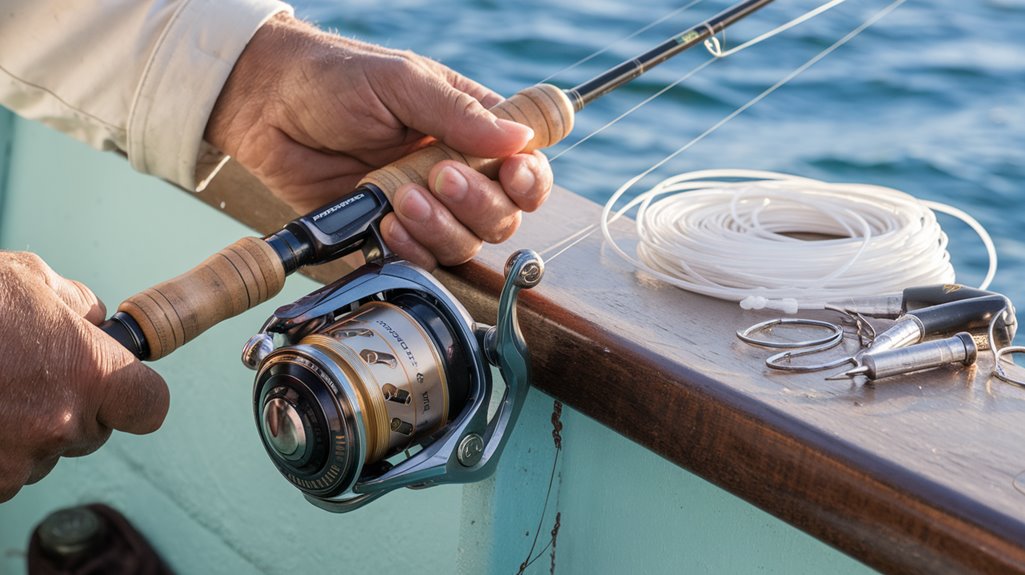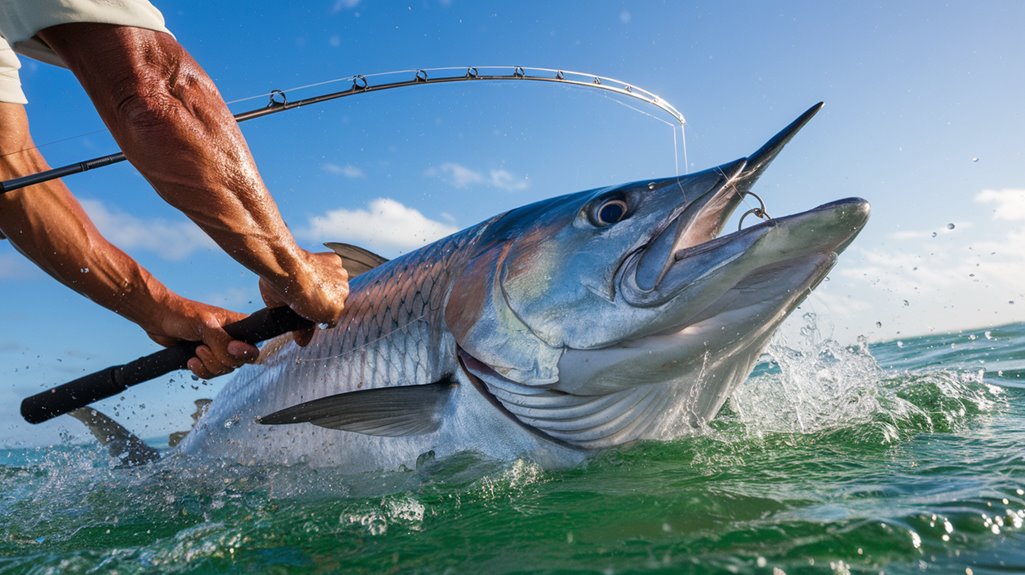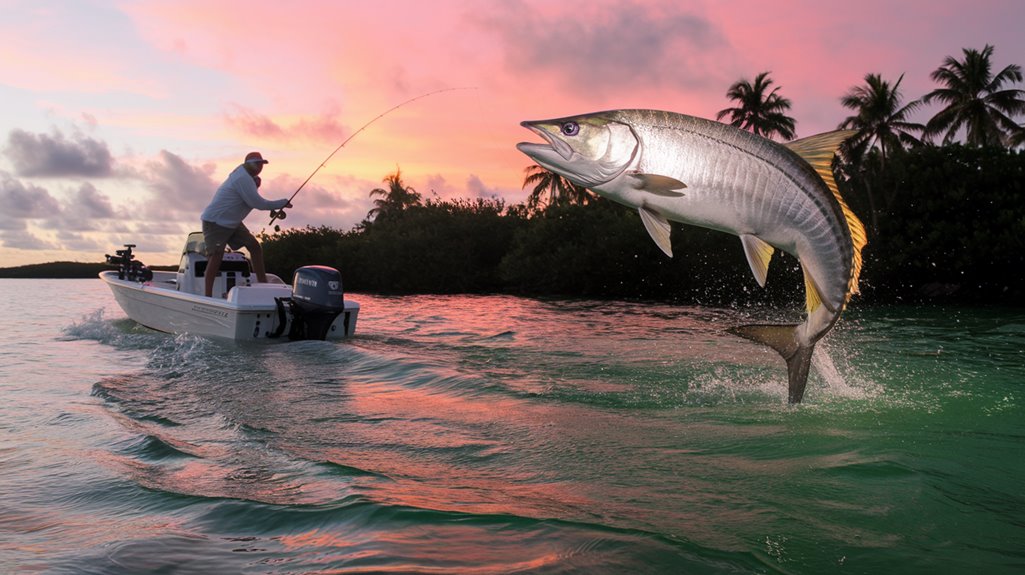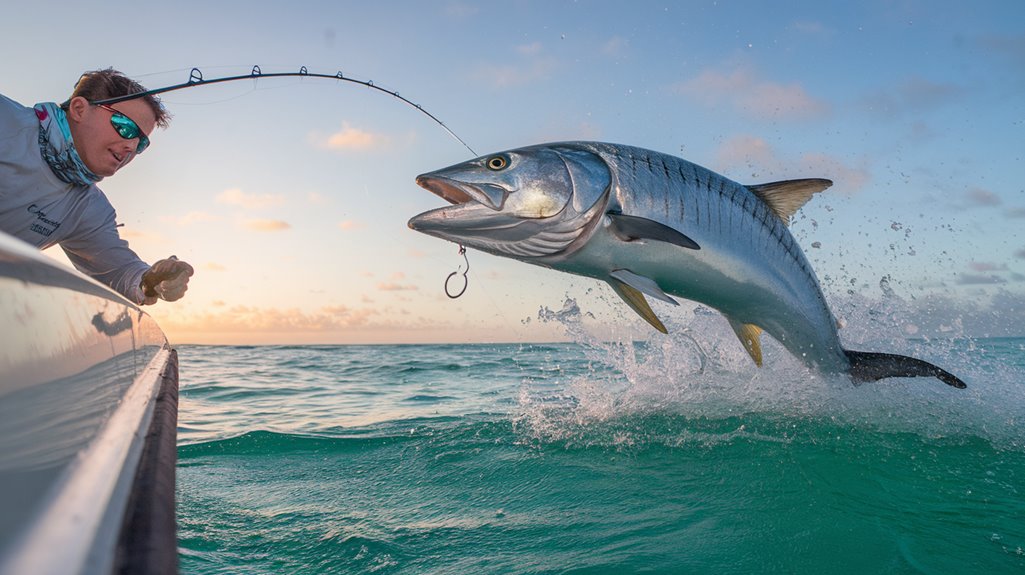You'll need more than just luck to land one of sport fishing's most challenging catches – the mighty tarpon. These prehistoric powerhouses, known as "silver kings," demand precise techniques and specialized gear to bring them boatside. Whether you're targeting the shallow flats of the Florida Keys or working deeper channels along coastal waters, your success hinges on understanding vital elements like tide patterns, seasonal movements, and proven fighting tactics that seasoned anglers have refined over decades.
- Key Takeaways
- Essential Gear Selection for Tarpon Battles
- Strategic Bait Presentation Methods
- Reading Water Conditions and Tarpon Behavior
- Advanced Hook Setting Techniques
- Mastering the Fight and Jump Response
- Seasonal Patterns and Peak Fishing Times
- Location Selection and Positioning Strategy
- Frequently Asked Questions
- Conclusion
Key Takeaways
- Use a heavy spinning rod (7-8) with 30-50 lb test line and circle hooks to handle tarpon's size and powerful strikes.
- Present live bait ahead of rolling tarpon patterns while maintaining a perpendicular approach to avoid spooking fish.
- Fish during peak months (May-June) in early morning or late evening when tarpon are most active in shallow waters.
- Master the "bow to the King" technique during jumps and maintain proper line tension throughout the fight.
- Target areas with clear water, strong currents, and abundant bait sources near channel edges for optimal fishing success.
Essential Gear Selection for Tarpon Battles

When targeting the mighty tarpon, selecting the right gear can mean the difference between landing your trophy and losing it during an epic battle. You'll need a 7-8 heavy or extra-heavy spinning rod paired with a 6000-8000 size reel for fighting the fish effectively. For your line setup, spool up with 30-50 lb test, connecting it to an 80 lb or higher fluorocarbon leader that's at least 6 feet long. When rigging for tarpon fishing, wide gap circle hooks are your best choice, whether you're using live bait or artificial lures. If you're opting for artificials, select substantial jigs and jerk baits with robust hooks that can withstand powerful strikes. Don't be tempted to use lighter tackle – your gear must handle 100+ lb fish to guarantee quick fights and successful releases.
Strategic Bait Presentation Methods
When targeting tarpon, you'll need to position your live bait ahead of their rolling pattern while maintaining a perpendicular approach to avoid spooking these cautious predators. Your artificial lure presentations should incorporate strategic pauses and varied retrieve speeds, switching between slow and quick movements based on the fish's response level. For crab imitations, you'll want to work them with subtle, natural movements that mimic a fleeing crustacean, keeping your offering in the strike zone longer by maintaining proper depth control.
Live Bait Positioning Tips
Successful tarpon fishing hinges on precise live bait positioning techniques that enhance your chances of a strike. You'll want to position your live bait with a 6-8 foot leader, using a bobber to control depth based on tarpon activity. When using circle hooks, you'll increase your hook-up success rate by targeting the corner of the mouth.
- Monitor mullet bait closely and adjust your rod tip when tarpon miss strikes
- Wait for steady pressure on the line when fishing with live crabs
- Keep a slack line with dead bait to avoid spooking fish
- Position your bait at the ideal depth using bobbers and leaders
- Use circle hooks to improve hook-set effectiveness
Remember to maintain proper tension and respond to pressure on the line appropriately, depending on whether you're using mullet, crabs, or dead bait as your choice of live bait.
Artificial Lure Movement Patterns
Three essential movement patterns define successful artificial lure presentation for tarpon fishing. When you're working soft plastics or jerkbaits, maintain a steady retrieve to mimic struggling baitfish. You'll want to adjust your technique based on the tarpon's response, incorporating strategic twitches to create enticing, erratic motions.
| Pattern Type | Application | Target Area |
|---|---|---|
| Steady Retrieve | Rolling Fish | Channels |
| Erratic Motion | Active Feeds | Sand Holes |
| Lead Casting | Surface Action | Structures |
When you spot rolling fish, cast your artificial lures ahead of their path, allowing the bait to intersect with their movement naturally. Don't hesitate to employ blind casting in proven tarpon territories when fish aren't visible. If the tarpon tries to follow but doesn't commit, vary your retrieve speed to trigger that decisive strike.
Crab Presentation Techniques
Live crab presentations demand precise handling to maximize your tarpon hookup potential. When you're using live crabs, focus on maintaining line tension while staying alert for the initial bite. You'll want to feel steady pressure before initiating your hook set, using a measured thump rather than an aggressive jerk.
- Position your rod tip low during the fight to allow necessary slack
- Wait for definitive pressure before setting the hook
- Use gentle, steady pressure instead of forceful hook sets
- Monitor line tension continuously throughout the battle
- Keep your rod tip pointed downward when the fish jumps
Proper crab presentation techniques require patience and finesse. You'll need to maintain constant awareness of your line tension and rod position, especially when the tarpon becomes aggressive. Remember to give slack in the line during jumps to prevent the hook from tearing free.
Reading Water Conditions and Tarpon Behavior
You'll find tarpon revealing their location through their distinctive rolling behavior, especially during tide changes and along current edges where they actively hunt for baitfish. When you spot rolling fish, quickly assess their travel direction and position yourself to cast ahead of their path, particularly near structural elements like sand holes and channels where current flow creates natural feeding zones. These magnificent fish tend to be most active in clear, calm waters during overcast conditions, when they'll often roll consistently throughout the day rather than limiting their surface activity to dawn and dusk hours.
Current Flow Patterns
Mastering current flow patterns is a critical skill for targeting tarpon, as these powerful game fish strategically position themselves where water movements create natural feeding advantages. You'll find these large tarpon concentrating in areas where currents converge, setting up perfect ambush points for baitfish. Understanding these patterns will greatly improve your success when fishing for tarpon, especially during outgoing tides near inlets and passes.
- Monitor points and cuts where current flow creates natural bait funnels
- Watch for rolling or jumping tarpon in areas of concentrated bait movement
- Time your fishing around peak current periods when feeding activity increases
- Focus on structure areas that interrupt and redirect water flow
- Position your boat upstream of convergence zones where tarpon actively feed
Spotting Rolling Fish Behavior
A telltale splash and silver flash at the surface signals one of fishing's most exciting moments – spotting rolling tarpon. You'll have the best chances of spotting rolling fish during early morning and late evening hours, particularly when tides are changing. Focus your attention on shallow grass flats, bridges, and sandbars, as these prime locations consistently attract tarpon activity.
When you spot rolling fish, pay close attention to their direction of travel. Position yourself to cast lures ahead of their path, increasing your odds of a successful catch. Don't limit your fishing to sunny days – overcast conditions often trigger increased rolling behavior throughout the day. By learning to read these surface indicators and understanding tarpon's air-gulping habits, you'll dramatically improve your ability to locate and target these prized gamefish.
Advanced Hook Setting Techniques

Setting hooks effectively on tarpon requires distinct techniques based on your tackle choice and fishing method. Each approach demands specific timing and movements to secure your catch in the tarpon's tough mouth.
- With circle hooks, point your rod directly at the fish and maintain a tight line, letting the hook set naturally
- When fly fishing, execute multiple vigorous strip-sets to guarantee solid hook penetration
- For live bait, wait for a steady thump, then reel and lift your rod to a 45-degree angle
- During bottom fishing, pull back immediately upon feeling pressure and reel quickly before the fish jumps
- With artificial lures, respond to the bite with fast reeling and an upward rod tip movement
These specialized techniques account for tarpon's hard mouths and acrobatic behavior, greatly improving your chances of landing these powerful gamefish.
Mastering the Fight and Jump Response
Once you've hooked a tarpon, your success depends heavily on proper jump response and fight management techniques. When fighting a fish of this caliber, you'll need to master the "bow to the King" technique – immediately dropping your rod tip when the tarpon jumps to prevent the hook from pulling free. You'll have the best chance of landing your catch by maintaining strategic line management throughout the fight.
| Action | Technique | Result |
|---|---|---|
| Jumping | Bow to fish | Prevents hook pull |
| Line Control | Keep moving | Maintains pressure |
| Rod Position | Low when jumping | Creates slack |
| Fighting Angle | Change frequently | Disorients fish |
| Surge Response | Add drag | Controls movement |
Remember to avoid keeping the line tight during jumps and be ready to respond to sudden surges by adjusting your drag accordingly.
Seasonal Patterns and Peak Fishing Times

Successfully landing a tarpon isn't just about mastering the fight – timing your fishing expedition can make all the difference. Understanding their migratory patterns and peak fishing months will greatly boost your chances of witnessing those spectacular tarpon jumps.
- Peak fishing months are May and June, when you'll find hundreds or thousands of fish along Florida's coast
- Look for rolling in shallow waters during early morning and late evening, especially during tide changes
- Overcast conditions create prime opportunities as tarpon roll throughout the day
- Best fishing areas feature clear water, strong current, and abundant bait
- You can target juvenile tarpon year-round in residential ponds and river mouths if you can't make the peak season
Location Selection and Positioning Strategy
To maximize your chances of landing a trophy tarpon, strategic positioning along beaches and sandbars is essential. Position your boat perpendicular to areas where you've spotted rolling tarpon to improve your casting accuracy. You'll find the most success during migration seasons from April to August, especially in locations with white sandy bottoms that make fish more visible.
Keep a close eye on tide changes, as these change periods offer prime fishing opportunities, particularly during early morning and late evening hours. When selecting your fishing locations, focus on areas where clear water meets channel edges and abundant bait sources are present. Scan for tarpon swimming parallel to the shoreline, and adjust your position accordingly. This targeted location selection approach will greatly increase your odds of a successful catch.
Frequently Asked Questions
What Is the Best Rig for Tarpon Fishing?
You'll want to use a sliding sinker fish-finder rig with 30-50lb test line, 80lb fluorocarbon leader, and wide-gap circle hooks. Combine wire and fluorocarbon leaders for shark protection.
What Is the Best Bait to Catch Tarpon?
You'll have the most success using live mullet around 8 inches long, live crabs, or fresh-cut ladyfish. These natural baits match tarpon's preferred forage and increase your chances of a strike.
How to Catch a Tarpon Fish?
Use 30lb test line with circle hooks for live bait. Cast ahead of rolling tarpon, maintain steady retrieves, and bow when they jump. Change angles while reeling and keep constant line tension.
What Attracts Tarpon?
You'll find tarpon attracted to large schools of baitfish, especially mullet and threadfins. They're drawn to clear water, bridge structures, and areas where other tarpon are rolling during tide changes.
Conclusion
You'll find that successful tarpon fishing combines precise gear selection, strategic presentation, and refined fighting techniques. By mastering these fundamentals while staying attuned to seasonal patterns and water conditions, you're setting yourself up for memorable catches. Remember to maintain proper tension during jumps, position yourself strategically in prime locations, and always respect these magnificent gamefish. Your dedication to these principles will yield exceptional results.

